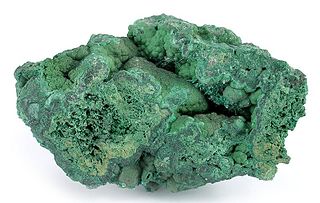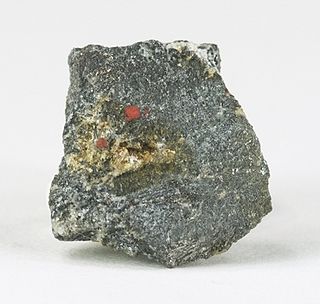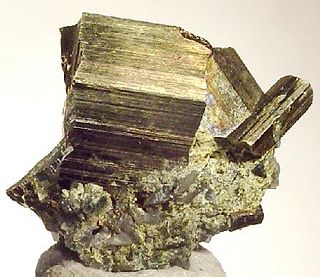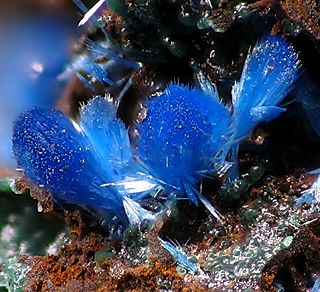 W
WAgardite is a mineral group consisting of agardite-(Y), agardite-(Ce), agardite-(Nd), and agardite-(La). They comprise a group of minerals that are hydrous hydrated arsenates of rare-earth elements (REE) and copper, with the general chemical formula (REE,Ca)Cu6(AsO4)3(OH)6·3H2O. Yttrium, cerium, neodymium, lanthanum, as well as trace to minor amounts of other REEs, are present in their structure. Agardite-(Y) is probably the most often found representative. They form needle-like yellow-green (variably hued) crystals in the hexagonal crystal system. Agardite minerals are a member of the mixite structure group, which has the general chemical formula Cu2+6A(TO4)3(OH)6·3H2O, where A is a REE, Al, Ca, Pb, or Bi, and T is P or As. In addition to the four agardite minerals, the other members of the mixite mineral group are calciopetersite, goudeyite, mixite, petersite-(Ce), petersite-(Y), plumboagardite, and zálesíite.
 W
WAktashite is a rare arsenic sulfosalt mineral with formula Cu6Hg3As4S12. It is a copper mercury-bearing sulfosalt and is the only sulfosalt mineral with essential Cu and Hg yet known. It is of hydrothermal origin. It was published without approval of the IMA-CNMNC, but recognized as valid species by the IMA-CNMNC Sulfosalts Subcommittee (2008).
 W
WAlgodonite is a copper arsenide mineral with formula: Cu6As. It is a gray white metallic mineral crystallizing in the hexagonal system. It has a Mohs hardness of 4 and a specific gravity of 8.38 - 8.72.
 W
WArthurite is a mineral composed of divalent copper and iron ions in combination with trivalent arsenate, phosphate and sulfate ions with hydrogen and oxygen. Initially discovered by Sir Arthur Russell in 1954 at Hingston Down Consols mine in Calstock, Cornwall, England, arthurite is formed as a resultant mineral in the oxidation region of some copper deposits by the variation of enargite or arsenopyrite. The chemical formula of Arthurite is CuFe23+(AsO4,PO4,SO4)2(O,OH)2•4H2O.
 W
WBayldonite (BAIL-done-ite) is a rare secondary mineral with the chemical formula PbCu3(AsO4)2(OH)2. It was first discovered in Penberthy Croft Mine, Cornwall, England, United Kingdom. It is named after its discoverer, John Bayldon (1837(8) – 1872). Specimens are also found in Tsumeb, Namibia, and Arizona, United States. It is sometimes used as a gemstone.
 W
WBoleite is a complex halide mineral with formula: KPb26Ag9Cu24(OH)48Cl62. It was first described in 1891 as an oxychloride mineral. It is an isometric mineral which forms in deep-blue cubes. There are numerous minerals related to boleite, such as pseudoboleite, cumengite, and diaboleite, and these all have the same complex crystal structure. They all contain bright-blue cubic forms and are formed in altered zones of lead and copper deposits, produced during the reaction of chloride bearing solutions with primary sulfide minerals.
 W
WBukovite is a rare selenide mineral with formula Tl2Cu3FeSe4. It is a brown to black metallic mineral which crystallizes in the tetragonal system.
 W
WTangeite, also known as calciovolborthite, is a calcium, copper vanadate mineral with formula: CaCu(VO4)(OH). It occurs as a secondary mineral that can be found in sandstone and also in the oxidized zones of vanadium bearing deposits.
 W
WCaledonite, whose name derives from Caledonia, the historical name of its place of discovery (Scotland), is a richly colored blue-green sulfate-carbonate mineral of lead and copper with an orthorhombic crystal structure. It is an uncommon mineral found in the oxidized zones of copper-lead deposits.
 W
WChalcostibite is a copper antimony sulfide mineral.
 W
WChanabayaite is the first recognized triazolate mineral, having the formula Cu2(N3C2H2Cl 4.
 W
WCubanite is a yellow mineral of copper, iron, and sulfur, CuFe2S3.
 W
WDemesmaekerite is a rare uranium selenite mineral with the chemical formula: Pb2Cu5(UO2)2(SeO3)6(OH)6·2H2O.
 W
WEilat Stone derives its name from the city of Eilat where it was once mined. It is a green-blue heterogeneous mixture of several secondary copper minerals including malachite, azurite, turquoise, pseudomalachite, chrysocolla. The Eilat stone is the National stone of Israel, and is also known as the King Solomon Stone.
 W
WEnargite is a copper arsenic sulfosalt mineral with formula Cu3AsS4. It takes its name from the Greek word enarge, "distinct". Enargite is a steel gray, blackish gray, to violet black mineral with metallic luster. It forms slender orthorhombic prisms as well as massive aggregates. It has a hardness of 3 and a specific gravity of 4.45.
 W
WFreibergite is a complex sulfosalt mineral of silver, copper, iron, antimony and arsenic with formula (Ag,Cu,Fe)12(Sb,As)4S13. It has cubic crystals and is formed in hydrothermal deposits. It forms one solid solution series with tetrahedrite and another with argentotennantite. Freibergite is an opaque, metallic steel grey to black and leaves a reddish-black streak. It has a Mohs hardness of 3.5 to 4.0 and a specific gravity of 4.85 - 5. It is typically massive to granular in habit with no cleavage and an irregular fracture.
 W
WGermanite is a rare copper iron germanium sulfide mineral, Cu26Fe4Ge4S32. It was first discovered in 1922, and named for its germanium content. It is only a minor source of this important semiconductor element, which is mainly derived from the processing of the zinc sulfide mineral sphalerite. Germanite contains gallium, zinc, molybdenum, arsenic, and vanadium as impurities.
 W
WHemusite is a very rare isometric gray mineral containing copper, molybdenum, sulfur, and tin with chemical formula Cu6SnMoS8. It was discovered by Bulgarian mineralogist Georgi Terziev in 1963. He also described it and named it after Haemus, the ancient name of Stara planina (Balkan) mountains in Europe. The type locality is Chelopech copper ore deposit, Bulgaria. Later tiny deposits of hemusite were found in Ozernovskoe deposit, Kamchatka, Russia; Kawazu mine, Rendaiji, Shimoda city, Chūbu region, Honshu Island, Japan; Iriki mine, Iriki, Satsuma-gun, Kagoshima Prefecture, Kyushu Region, Japan; Kochbulak deposit, Tashkent, Uzbekistan. Hemusite occurs as rounded isometric grains and aggregates usually about 0.05 mm in diameter and in association with enargite, luzonite, colusite, stannoidite, renierite, tennantite, chalcopyrite, pyrite, and other minerals.
 W
WIcosahedrite is the first known naturally occurring quasicrystal phase. It has the composition Al63Cu24Fe13 and is a mineral approved by the International Mineralogical Association in 2010. Its discovery followed a 10-year-long systematic search by an international team of scientists led by Luca Bindi and Paul J. Steinhardt to find the first natural quasicrystal.
 W
WKesterite is a sulfide mineral with a formula Cu2(Zn,Fe)SnS4. In its lattice structure, zinc and iron atoms share the same lattice sites. Kesterite is the Zn-rich variety whereas the Zn-poor form is called ferrokesterite or stannite. Owing to their similarity, kesterite is sometimes called isostannite. The synthetic form of kesterite is abbreviated as CZTS (from copper zinc tin sulfide). The name kesterite is sometimes extended to include this synthetic material and also CZTSe, which contains selenium instead of sulfur.
 W
WKhatyrkite ( KAT-ee-ər-kyte) is a rare mineral which is mostly composed of copper and aluminium, but may contain up to about 15% of zinc or iron. Its chemical structure is described by an approximate formula (Cu,Zn)Al2 or (Cu,Fe)Al2. It was discovered in 1985 in a placer in association with another rare mineral cupalite ((Cu,Zn,Fe)Al). These two minerals have only been found in the area of the Listvenitovyi Stream, in the Khatyrka zone of the Koryak Mountains, in Beringovsky District, Chukotka, Russia. Analysis of one of the samples containing khatyrkite showed that the small rock was from a meteorite. A geological expedition has identified the exact place of the original discovery and found more specimens of the meteorite. The mineral's name derives from the Khatyrka (Russian: Хатырка) zone where it was discovered. Its type specimen (defining sample) is preserved in the Mining Museum in Saint Petersburg, and parts of it can be found in other museums, such as Museo di Storia Naturale di Firenze.
 W
WKostovite is a rare orthorhombic-pyramidal gray white telluride mineral containing copper and gold with chemical formula AuCuTe4.
 W
WLautite is a rare mineral belonging to the class of sulfides and sulfosalts with the general formula CuAsS. It is orthorhombic and is known to form up to 2.3 cm long prismatic or flat crystals. It is also found as grains or masses.
 W
WOosterboschite is a rare selenide mineral with the formula (Pd,Cu)7Se5. It crystallises in the orthorhombic crystal system. It has a creamy yellow colour and a Moh's hardness of 5. It is often found as grains with no clear shape. The crystals are opaque and often no bigger than 0.4 mm.
 W
WPenroseite is a rare selenide mineral with formula (Ni,Co,Cu)Se2. It has a gray-steel color and black streak with a hardness of 3. It is an isometric mineral, 2/m3. Penroseite was first discovered in 1925 in a Bolivian rhyolite. It was named for Richard Penrose (1863–1931), an economic geologist.
 W
WSchmiederite is a secondary mineral in the oxidized zone of selenium-bearing hydrothermal base metal deposits. Its chemical formula is Pb2Cu2(Se4+O3)(Se6+O4)(OH)4.
 W
WStannite is a mineral, a sulfide of copper, iron, and tin.
 W
WZhanghengite is a mineral consisting of 80% copper and zinc, 10% iron with the balance made up of chromium and aluminium. Its color is golden yellow. It was discovered in 1986 during the analysis of the Bo Xian meteorite and is named after Zhang Heng, an ancient Chinese astronomer.
 W
W